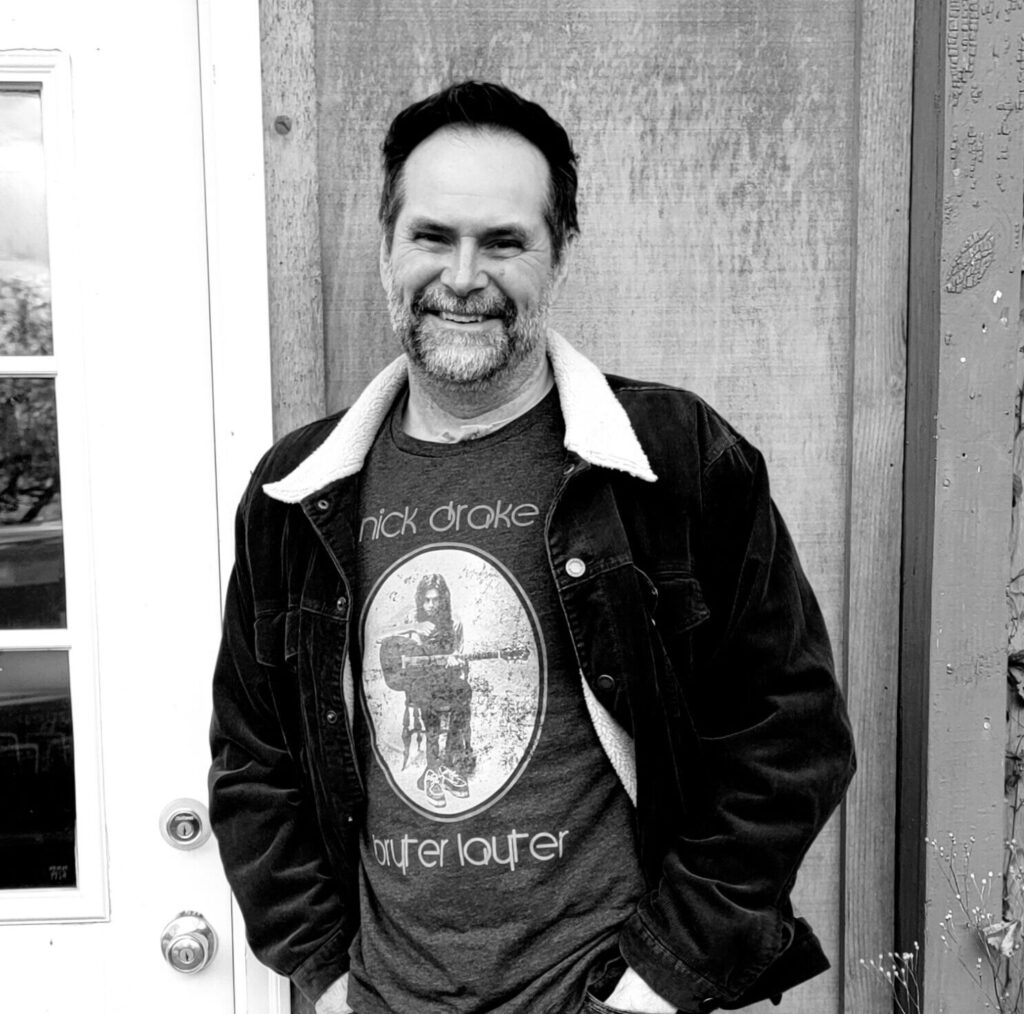
By Edward Karshner
My day job is researching the intersection of time and folklore. I study how stories reveal an understanding of ourselves in time. Do we flounder in, what David Southwell calls, “the warped gravity” of nostalgia? Or do we founder under the crushing weight of fatalism? In folktales, I’m always looking for a third way that doesn’t limit our ability to choose but, instead, offers the widest possibility of choice.
For two weeks, in the summer of 2022, I had the opportunity to work in Berea College’s Archives and Special Collections as a research fellow. I spent my days pouring over the collected works of folklorist Leonard Roberts. In the Roberts collection, I came across the character of Dan Ramey, a trickster figure and notorious liar. In one story, Dan is walking toward a jobsite when one of the workers says “Hey, Dan! Tell us the biggest one (lie) you know this morning. Dan replies “Ah, hell, I ain’t got time. Your father died this morning and I’m on my way to Norton after his burial clothes.” The man drops his tools and hurries home only to find his father alive and well on the front porch. The man confronts Dan wanting to know why he would have said something like that. Dan answers “Well, you asked me to tell you the biggest lie I knowed, and I did.”
What I find fascinating about this story is that the man asks for a lie, from a liar, and then falls for the lie. While no one likes to be lied to, this story reveals our almost playful desire to be deceived. It reminds me of Nietzsche’s observation in his essay “On Truth and Lies in a Nonmoral Sense” that we have an “inclination to allow [ourselves] to be deceived and . . . enchanted with happiness when [told] epic fables as if they were true.” Those of us who write, read, and spend our time spinning yarns bank on this willingness to be deceived. But we also know that it’s not a malicious deception but an invitation to willingly participate in fiction.
In another story, Dan convinces a group of workmen to abandon their job site and go to the next town to buy meat since their town has a shortage. Of course, there’s no meat. When confronted, Dan replies “I told you they had side meat as big as a table and four inches thick. A damn fool would know better than that.”
Dan, like all tricksters, crafts with words a story altering a listener’s perception of reality. Folklorist Carl Lindahl calls this “verbal agency,” the power to rename situations in which characters find themselves. As writers, we tell the biggest one we know in the most engaging way possible. However, rather than seek to deceive, our fiction is an invitation for a reader to discover their “literary agency” where readers, as my student Bobby Bradley put it, “contribute to their story in a meaningful way.”
In the Roberts collection, Edwin Lacy from Morgan County, Kentucky says that “the old timer must be careful, lest he do some thoughtless act that would bring down some calamity on his head.” Lacy’s observation gets to the necessity of a lie. The idea of fiction as a reminder to act purposefully, thoughtfully—not like a damn fool. Story becomes a place where both writer and reader participate in the willing deception of fiction, that suspension of disbelief, where we can explore the “maybe,” mindfully.
I teach in a program where our goal is to wrap creative and professional writing in the cloak of storytelling. We want students to become effective storytellers who utilize the verbal agency of folklore to encourage the literary agency of readers. The line between art and content creation cunningly blurred. I also teach a doctoral course to professionals who learn the skills a folklorist uses in observation and recording and the writing conventions of ethnography to understand the “folklore” of their corporations or three letter government agencies. The idea being that effective communication and leadership comes from being a storyteller with the ability to see the world through other perspectives and to express those alternate views with clarity and empathy. To use story, as I’ve talked about, not to deceive or influence, but to encourage participation in the discovery of the possible.
In Making Our Future: Visionary Folklore and Everyday Culture in Appalachia, Emily Hilliard defines folklore as the expression of the “creative practices we learn by living our lives” while also looking at how these expressions of “vernacular culture (folklore) and mass culture (literature) intersect in hybridized forms.” If we take fiction to, like folklore, have a pedagogical function, then what are we trying to teach ourselves through these stories? And how do the old stories, re-written as literature, continue to help us make sense of the “who of where we are”?
Since my time in Berea, reading folklore all day and then tucking myself in with the best contemporary fiction at night, I’ve considered how folklore is re-told as fiction. This year my columns explore the movable hosts of metaphors from folklore that are re-signified in our stories and our literature. I want to test the old folk-spell “Time and Space is Everything” by considering how fiction reclaims our “everything” through storytelling, not as an act rooted in a lost past or in a decided future but as revealing the possibilities available to us now. There has always been a conversation going on between folklore and literature. Folklorist Mark Norman believes that even as folklore is forgotten, it still speaks to us about how we were and how we are. Maybe, if we listen to the stories we tell each other and hear the tales we tell ourselves, we can start to, also, consider how we should be.
For Further Reading (in order of appearance):
David Southwell can be found on Twitter at @cultauthor and his fantastic, misremembered folklore of Hookland is also on Twitter at @HooklandGuide.
The Leonard Roberts Collection is located at Berea College’s Special Collections and Archives. They are online at https://libraryguides.berea.edu/aboutsca and Twitter @BereaArchives. Definitely worth a look.
Carl Lindhal’s book Perspectives on the Jack Tales and Other North American Marchen (Indiana University Press, 2001) is a fantastic, scholarly look at the Jack Tales.
Emily Hilliard’s wonderful book: In Making Our Future: Visionary Folklore and Everyday Culture in Appalachia and she is on Twitter at @hey_emhilly. Her chapter on Breece D’J Pancake is right up a Reckon reader’s alley.
Mark Norman, Twitter @Mr_Mark_Norman, is the driving force behind The Folklore Podcast (Twitter @folklorepod). This podcast and its extraordinary on-line lectures got me through the pandemic.
Read Ed’s other work here at Reckon:
The Fractured Mirror: The Tree and the Well at the Center of Folklore
The Fractured Mirror: Results Will Vary – The Disruptive Necessity of Story
The Fractured Mirror: Winter Solstice, Christmas, and the Axes of Time
Dinè Storyteller: A Conversation with Sunny Dooley

Edward Karshner
Edward Karshner was born in Ross County, Ohio and grew up in the Salt Creek Valley of Southeast Appalachia Ohio which draws together Ross, Hocking, and Pickaway Counties. After earning a Ph.D. in Rhetoric and Philosophy from Bowling Green State University, he began to explore cultural rhetoric as expressed in folklore. His primary interest was how landscape influences folk-ideologies. In the early part of his career, he travelled extensively in China, Slovakia, Austria, and the Czech Republic before spending over a decade working with the Dinè(Navajo). Now, as an Associate Professor of English at Robert Morris University, he has returned to researching, teaching and writing about Appalachian folklore, magic, and mysticism. A 2022 Research Fellow in Folklore at Berea College’s Special Collections and Archives, Karshner is the author of “These Stories Sustain Me” in the collection Appalachian Reckoning: A Region Replies to Hillbilly Elegy. His short fiction has appeared in the anthologies Haints and Hollers, Shelved (both from Mountain Gap Books) and It Came from the Swamp (Malarkey Books).
